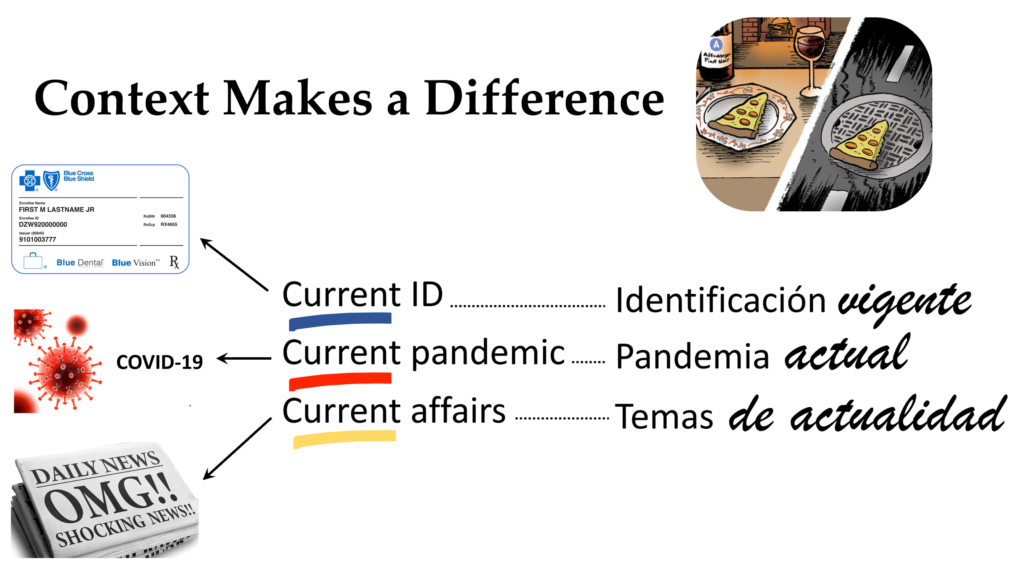
In a recent series of edits and translations, I found myself repeatedly fixing “isotopic breaks” that AI or inexperienced writers and translators had missed. An isotopy is a set of words and expressions that echo an idea throughout the text. Some linguists define it as a set of expressions linked by a common semantic denominator.
Bear with me, I know isotopy seems like such a technical term! But it simply means “same topic,” from combining the Greek-derived forms iso, same, and topic, subject of discussion. Maintaining isotopy means that won’t veer off-topic, introduce contradictory references, or mix figures of speech from different spheres.
Broken isotopies occur when the context for a word wasn’t right or the word wasn’t right for the context. In reference to my headline image, you’d hardly bring up the word “delectable” to describe a slice of pizza dumped on the street.
Now, the easiest way to create isotopy is to use words that belong together to weave threads of meaning. Throughout the text, words that belong together lend unity to the text by repeating, alluding to, or adding details about an certain idea by using related words and phrases, and figures of speech.
You will notice that the threads of meaning you create can respond to different connections. Some words are linked together by more abstract connections, some share more concrete ties. And it is useful to understand the differences. Here are some of the main types of connections between words:
Conceptual Isotopies
 In conceptual isotopies, words and phrases are linked by meaning. These clusters include words that share semantic features and belong to the same field. For instance, table and furniture have meaning in common. As you may know, table is a hyponym or more specific word than furniture, which is a more general word or hypernym. Words like table, chairs, desk, dresser, sofa, etc. are related by definition. Of course this conceptual relatedness can become quite abstract, as with mathematical concepts like the periodic functions sine, cosine, and tangent — and their reciprocals, cosecant, secant, and cotangent.
In conceptual isotopies, words and phrases are linked by meaning. These clusters include words that share semantic features and belong to the same field. For instance, table and furniture have meaning in common. As you may know, table is a hyponym or more specific word than furniture, which is a more general word or hypernym. Words like table, chairs, desk, dresser, sofa, etc. are related by definition. Of course this conceptual relatedness can become quite abstract, as with mathematical concepts like the periodic functions sine, cosine, and tangent — and their reciprocals, cosecant, secant, and cotangent.
Pragmatic Isotopies
In pragmatic isotopies , words are linked by habits and cultural ties. These clusters emerge from customary practices and cultural norms rather than through intrinsically shared meaning. Consider the words table, bowl, and bacon. What do they have in common? In essence, not much. They do not presuppose each other or overlap in meaning. Yet, they come seamlessly together in the context of ‘American breakfast.’ The fact that these items do not coexist in the breakfast practices of other cultures is testament to their conceptual distinction.
Sometimes, a set of cultural connections is so ingrained that we forget the connections depend on cultural norms. Depending on the audience you write for, relying on their ability to connect culturally related ideas can hinder their comprehension.
For example, if you use references to American football’s stop-and-go nature with 60 minutes of regulation time but only 11 minutes of action, you may lose a British reader accustomed to some 90 minutes of ongoing action in rugby or soccer.
Familiar Expressions
In sharing information with a reader, it is generally a good idea to add new information in the context of familiar information to scaffold understanding and learning. Occasionally, it is ok to surprise your reader. So, in writing and translation, it serves you well to know the crystallized expressions used in your subject matter. These expressions often started a innovative figures of speech but have lost their creative value and they are now so common that we no longer notice them. Among such expressions are:
- Figures of speech that have become common terms, like “mouth of a river” or “eye of a needle.”
- Figures of speech that have become collocations, like “wave of enthusiasm” or “a storm of allegations.” Collocations are words used together much more often than other equally reasonable options (maybe “gust of enthusiasm” or “hurricane of allegations.”)
- Figures of speech that have become idioms, like “being over the moon,” “having butterflies in your stomach.” Idioms are formulaic or fixed expressions that no longer have a startling effect for their figurative meaning even when they do not mean what the words literally say.
Words in Context
All of these microcosms of meaning come into play when you write or translate and need to bring your words to the right context and bring the right context to your words. Context matters because:
- words are polysemic, and
- people are not only different from each other in their abilities and interests, but also wear many hats as individuals.
About a): The fact that a word looks the same in different contexts is not enough indication that they will mean the same. We call homonyms those words that have the same spelling (or pronunciation in speech) but different meanings. Words can even change their part of speech and look the same.
In translation, we need to pay additional attention to:
- false cognates: words that look alike in two languages but mean different things. For instance, embarrassed and embarazada (meaning ashamed versus pregnant) or fabric and fábrica (cloth versus factory.
- contextual translations of a single word that requires different words in the target language. For instance, one of the words of the moment, mask, can translate into Spanish as máscara, antifaz, careta, barbijo, gafas, ocultar, and camuflar, among others (meaning mask, decorative mask, fencing mask, surgical mask, scuba mask, to hide, to conceal)
About b): We need to adapt content and form to our audience. This becomes particularly tricky because audiences differ not only in shared group features but in individual features as well. For instance, the content, style, and depth I find appropriate, useful, interesting, or fun as a mom may not be the same than those I favor as a professional, a friend, a daughter, or a boss.
Nowadays, with so much automation at work, writers, translators, and editors need to be particularly wary of context to make sure the right meaning is surfacing in the right way at the right time!
